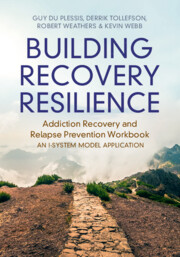 Building Recovery Resilience
Building Recovery Resilience Published online by Cambridge University Press: 28 May 2024
In this chapter the workbook’s previous chapters are integrated into an explanation of the dynamics that underlie the cycle of addiction. It highlights that when the I-System becomes hyperactive, individuals forfeit their innate capabilities for creative thought, open-mindedness, and resilience, exhibiting instead overly stringent expectations or assumptions about themselves, others, and circumstances. By presenting examples of thought patterns that obstruct resilience, the authors demystify the nature of problematic and unrealistic “I-System Requirements” or “the shoulds” in life that often breed frustration, physical tension, shame, or withdrawal. The reader is then guided on how to neutralize these negative thoughts or what the authors term the Depressor Storyline. They describe a self-perpetuating cycle often created between a Depressor Storyline and the Fixer Storyline, which involves the Depressor generating negative thoughts that snowball into a Storyline, while the Fixer incessantly devises stories on how to rectify self, others, or circumstances. The objective is to find means to deactivate the hyperactive I-System Requirements, which is crucial to freeing individuals from restrictive and repetitive patterns to attain a state of Natural Functioning.
To save this book to your Kindle, first ensure [email protected] is added to your Approved Personal Document E-mail List under your Personal Document Settings on the Manage Your Content and Devices page of your Amazon account. Then enter the ‘name’ part of your Kindle email address below. Find out more about saving to your Kindle.
Note you can select to save to either the @free.kindle.com or @kindle.com variations. ‘@free.kindle.com’ emails are free but can only be saved to your device when it is connected to wi-fi. ‘@kindle.com’ emails can be delivered even when you are not connected to wi-fi, but note that service fees apply.
Find out more about the Kindle Personal Document Service.
To save content items to your account, please confirm that you agree to abide by our usage policies. If this is the first time you use this feature, you will be asked to authorise Cambridge Core to connect with your account. Find out more about saving content to Dropbox.
To save content items to your account, please confirm that you agree to abide by our usage policies. If this is the first time you use this feature, you will be asked to authorise Cambridge Core to connect with your account. Find out more about saving content to Google Drive.